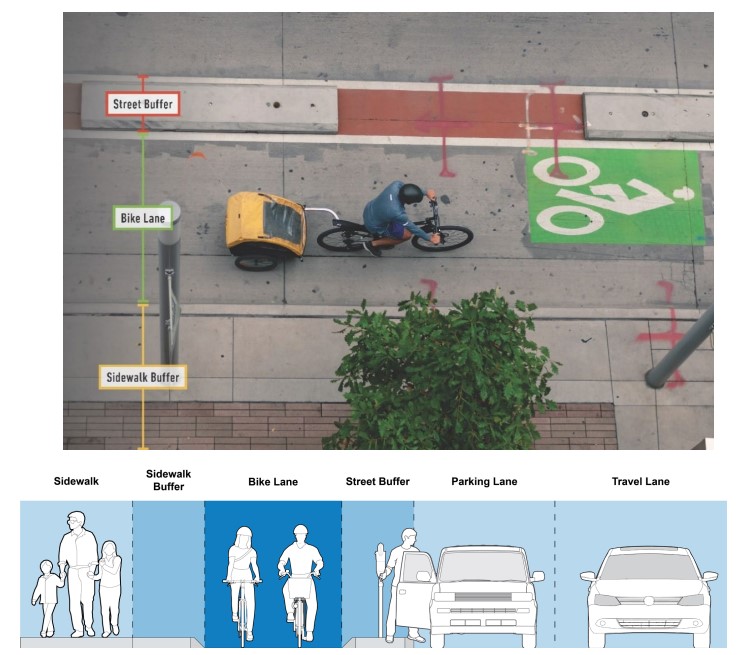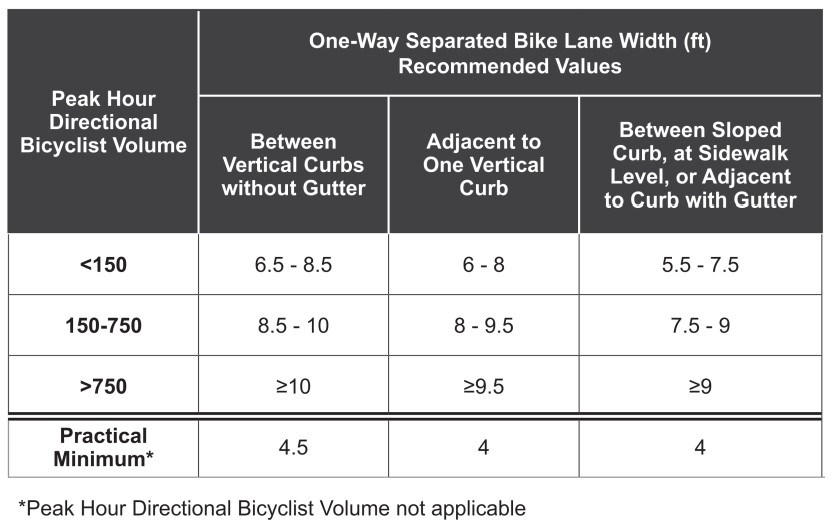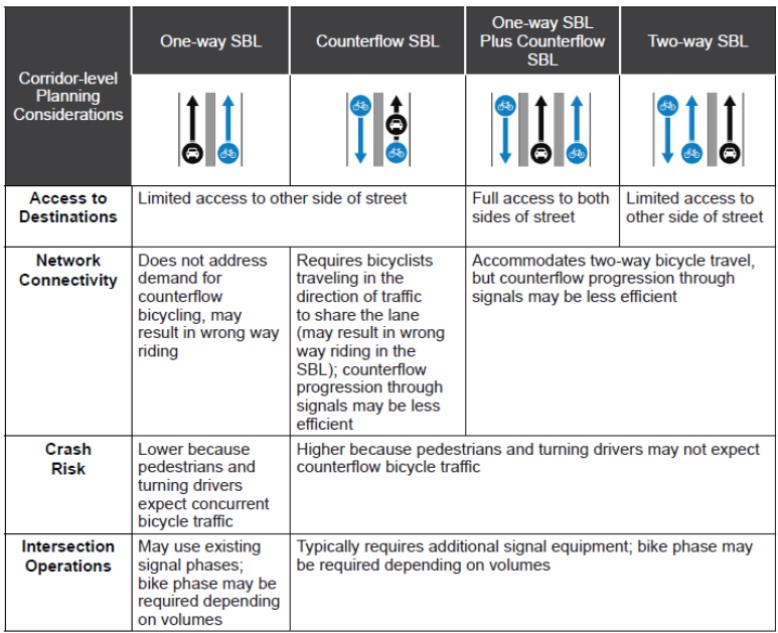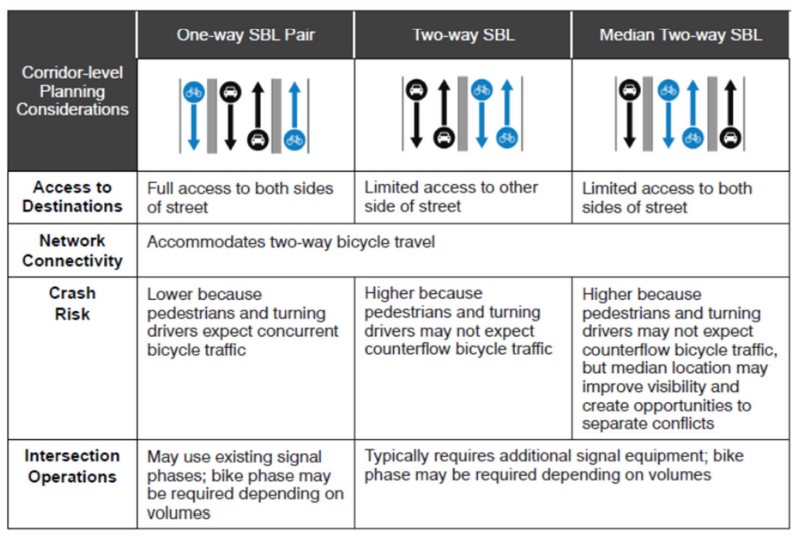18.4.2 Separated Bike Lanes

Figure 18-17: Example Separated Bike Lane Schematic
A separated bike lane is a bicycle lane that is physically separated from the adjacent motor vehicle traffic by vertical elements in the street buffer. They typically are designed to operate one-way but may also operate two-way. These are sometimes also referred to as protected bike lanes or cycle-tracks. Separated bike lanes combine the user experience of a shared use sidepath with a designated area for bike use only like a conventional bicycle lane, separate from pedestrians. They are distinct from the sidewalk but may be at sidewalk level (see Cambridge, MA, example). Vertical elements separating the bike lane from the travel lane may include continuous raised medians, flexible posts, intermittent concrete curbing (see Austin, TX, example), or parked vehicles
Separated bicycle lanes are more appealing to a wider range of bicyclists on higher volume and higher speed roads than striped bike lanes. They avoid the conflict with an opening car door and prevent motor vehicles from driving, stopping, or waiting in the bikeway. They also provide greater comfort to pedestrians by separating them from bicyclists operating at higher speeds and further separating pedestrians from motor vehicles. Full guidance can be found in FHWA Separated Bike Lane Planning and Design Guide,
and the
. See
for examples of separated bike lanes.

Figure 18-18: Examples of Separated Bike Lanes by Separation Types
The cross section of a separated bike lane has three distinct zones (see
):
- Bike lane– The bike lane is the space in which the bicyclist operates. It is located between the street buffer and the sidewalk buffer.
- Street buffer– The street buffer separates the bike lane from motor vehicle traffic.
- Sidewalk buffer– The sidewalk buffer separates the bike lane from the sidewalk.

Figure 18-19: Separated Bikeway with Three Distinct Zones
18.4.2.1 Application
Raised medians, curbs, or other low-profile, hard separated bike lanes should only be used in locations with speeds of 45 mph or less.
Separated bike lanes with flexible posts or crashworthy barriers are allowable for highspeed roadways.
Raised separated bike lanes (at sidewalk level) are allowable for all speeds.
18.4.2.2 Bike Lane Width
The desirable width of a separated bike lane depends upon the volume of users and the context of the design as shown in
for one-way separated bike lanes. Two-way separated bike lane widths should follow the previous guidance in
(Shared
Use Path Widths). The use of constrained dimensions should only be considered:
- For limited distances;
- As an interim measure where the larger values will result in the preferred design not being constructible; and
- At locations with low volumes of bicyclists where those volumes are anticipated to remain low (< 50 bicyclists/hour).
- See for guidance on buffers on two-way separated bike lanes.
Table 18-10: One-Way Separated Bike Lane Widths (Recommended)

The sidewalk buffer zone separates the sidewalk from the separated bike lane to communicate the sidewalk and the separated bike lane are distinct spaces. There is no minimum width, however, it is necessary to consider the needs of vegetation or street furniture if that is provided as the buffer. Sidewalks buffers need to include a detectable edge so pedestrians with vision disabilities can distinguish between the bike lane zone and the sidewalk. The sidewalk buffer zone may include:
- Street furniture or other vertical elements (such as a row of street trees);
- Continuous landscaping; or
- A curb to separate the bike lane from the adjacent sidewalk.
Separated bicycle lanes that are raised to sidewalk level with a wider buffer from traffic provide a high level of separation from traffic, but often require road reconstruction. The street buffer between the bike lane and travel lanes is needed to improve bicyclists’ comfort and to create space for vertical elements to reinforce the separation:
- For one-way separated bike lanes separated from vehicular traffic by a raised median or curb (low-speed), a minimum 2-ft buffer (measured from face of curb to face of curb) is required (see above);
- For non-curbed separated bike lanes, a minimum of a 2-ft buffer is required for low-speed conditions, and 3-ft for highspeed conditions;
- Additional buffer area is recommended to improve bicyclists’ comfort and to increase separation between bicyclists and vehicular traffic;
- See the for guidance on buffers on two-way separated bicycle lanes. Two-way separated bicycle lanes also need to meet the guidance in and with respect to intersecting driveways, and conflict points; and
- In scenarios where there is none, or limited space for a street buffer, designers may consider a raised bike lane, see
Continuous or intermittent vertical elements such as raised medians or flexible delineator posts are needed in the street buffer to provide separation between motor vehicle traffic and the bike lane. Designers should ensure that the vertical elements are visible to approaching bicyclists and motorists. In some cases, vertical elements should be supplemented with a striped buffer to clearly delineate the buffer zone. The placement of vertical elements within the street buffer should also consider the need for shy distance to the bikeway and to the travel lane, and the door-swing of parked cars adjacent to areas of on-street parking. See
for additional guidance for the marking of buffers.
18.4.2.3 Signing and Marking
18.4.2.4 Bicyclist Design Speed
For separated bike lanes in urban areas, a target design speed of 15 mph is generally appropriate. Higher design speeds may introduce safety challenges where bicyclists interact with motorists and pedestrians. Lower bicyclist and motorist operating speeds at conflict points allow bicyclists and motorists more time to perceive potential conflicts. This is particularly important at intersections with separated bike lanes.
18.4.2.5 Cross Slope and Grade
Cross slopes of 1 percent are more comfortable for people with disabilities and people bicycling with more than two wheels (e.g., cargo bike, adult tricycles, or trailers); however, cross slope may match existing roadway conditions without a maximum where necessary
18.4.2.6 Other Considerations
Separated bicycle lanes that are protected from traffic by a row of on-street parking offer a greater degree of separation. Additional vertical elements may be required to keep parked vehicles within the parking lane.
During the concept design stage for a separated bikeway, it is necessary to determine if it would be more appropriate to place a one-way separated bike lane on each side of the street, or to place a two-way separated bike lane or sidepath on one or both sides of the street. Selecting the appropriate configuration requires an assessment of many factors, including safety, overall connectivity, ease of access, available ROW, curbside uses, intersection operations, ingress and egress at the termini, maintenance, and feasibility.
and
provide an overview of trade-offs for various scenarios.
Table 18-11: Separated Bike Lane Configurations on a One-Way Street

Table 18-12: Separated Bike Lane Configurations on a Two-Way Street

NOTE: A raised curb separator on a separated bike lane may be a tripping hazard if it is located near a pedestrian path. Mitigation may include high visibility markings, offset the raised curb separator from the crosswalk, and add flexible delineators.